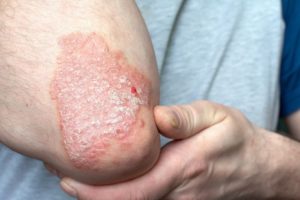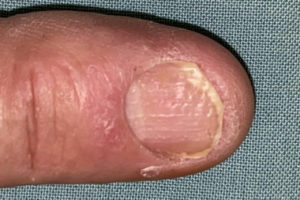10 psoriasis facts
In this article, we will describe 10 facts about psoriasis. This is mainly for health professionals.
5 Key Points
-
Psoriasis is a chronic inflammatory skin condition characterised by well-demarcated, scaly, erythematous plaques
-
Prevalence is very common in the UK, affecting 2% of the population
-
Cause is unknown but multifactorial: genetic predisposition, environmental factors, and immune system dysfunction contribute to its development
-
Diagnosis is primarily clinical, supported by history and physical examination
-
Treatment options include topical treatments, light therapy, and systemic medications.
1. Definition
- Psoriasis is a chronic, non-communicable skin condition characterized by abnormal keratinocyte proliferation and immune system dysregulation.
- Results in inflammation and scaling of the skin, leading to significant physical and psychological morbidity.
Types
- Plaque psoriasis – is the most common type of psoriasis. About 80-90% have plaque psoriasis
- Inverse psoriasis– appears in skin folds. It causes thin plaques without scales
- Guttate psoriasis – may appear after a sore throat caused by a streptococcal infection. It looks like small, red, drop-shaped scaly spots and often affects children and young adults
- Pustular psoriasis – has small, pus-filled bumps on top of plaques
- Erythrodermic psoriasis – is a severe type of psoriasis that affects a large area (more than 90%) of your skin. which causes red and scaly skin over much of your body.
- Nail psoriasis – causes skin discoloration, pitting and changes to fingernails and toenails.
2. Epidemiology
-
Estimated prevalence in the UK: 2% (approximately 1.5 million people)
-
More common in Caucasians than other ethnic groups
-
Peak onset: 20-30 years and 50-60 years
-
Female-to-male ratio: 1:1.
3. Risk Factors
-
Family history (first-degree relative)
-
Obesity
-
Smoking
-
Excessive alcohol consumption
-
Stress
-
Certain medications (e.g. lithium, beta-blockers)
-
Infections (e.g. streptococcal infections).
4. Causes
-
Genetic predisposition (HLA-Cw6, PSORS1)
-
Immune system dysfunction (T-cell activation, cytokine imbalance)
-
Environmental triggers (e.g. skin trauma, cold weather)
-
Abnormal keratinocyte proliferation and differentiation.
5. Symptoms
-
Well-demarcated, erythematous plaques with silvery scales

-
Commonly affected areas: elbows, knees, scalp, lower back
-
Itching, burning, or stinging sensations
-
Skin cracking and bleeding
-
Nail changes (e.g. pitting, onycholysis)

-
Joint pain or stiffness (psoriatic arthritis).
6. Diagnosis
-
Primarily clinical, based on history and physical examination
-
Characteristic skin lesions and distribution
-
Supportive features: nail changes, scalp involvement.
Investigation
It is a clinical diagnosis so investigation is not routinely necessary; but may include:
-
Skin biopsy (to confirm diagnosis or rule out other conditions)
-
Blood tests (e.g. inflammatory markers, liver function)
-
Joint imaging (e.g. x-rays, ultrasound) for suspected psoriatic arthritis.
Differential Diagnosis
-
Eczema (atopic dermatitis)
-
Seborrhoeic dermatitis
-
Contact dermatitis
-
Lichen planus
-
Cutaneous lupus erythematosus.
7. Treatment
-
Topical treatment
-
Corticosteroids
-
Vitamin D analogues (e.g. calcipotriol)
-
Topical retinoids
-
-
Light therapy
-
UVB phototherapy
-
Psoralen plus UVA (PUVA)
-
-
Systemic medication
-
Methotrexate
-
Cyclosporin
-
Biological agents (e.g. etanercept, adalimumab)
-
-
Lifestyle modification
-
Weight management
-
Smoking cessation
-
Stress reduction.
-
When to see a doctor with psoriasis
-
New onset of skin lesions or symptoms
-
Worsening or unresponsive symptoms
-
Joint pain or stiffness
-
Suspicion of complications (e.g. skin infections, eye problems).
8. Complications
-
Skin infections (e.g. bacterial, fungal)
-
Eye problems (e.g. uveitis, conjunctivitis)
-
Psoriatic arthritis
-
Cardiovascular disease
-
Depression and anxiety.
9. Prognosis
-
Chronic condition with variable disease course
-
Response to treatment varies between individuals
-
Early treatment and lifestyle modifications can improve outcomes.
10. Prevention
-
Maintain a healthy lifestyle (e.g. balanced diet, regular exercise)
-
Manage stress
-
Avoid triggers (e.g. smoking, excessive alcohol, drugs known to cause or worsen psoriasis)
-
Regular skin checks and monitoring for complications.
Summary
We have described 10 facts about psoriasis. We hope it has been helpful.
Top Tip
If psoriasis is not improving, arrange a dermatology opinion (partly to consider biological agents).

